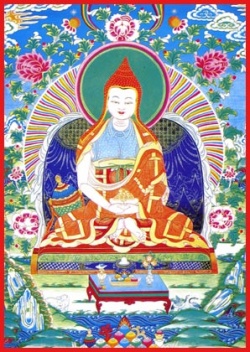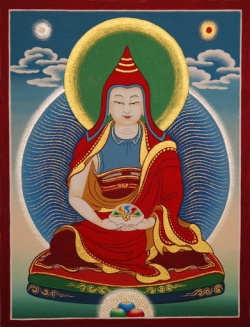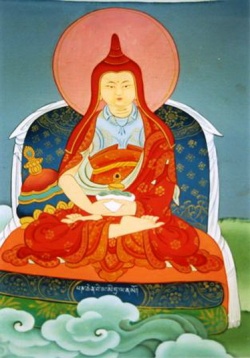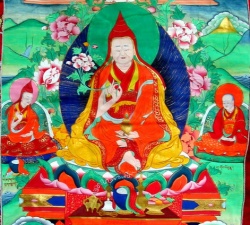Vimalamitra
Vimalamitra (in Sanskrit) (Chinese: 無垢友 (pinyin: Wúgòuyǒu); Tibetan: དྲི་མེད་བཤེས་གཉེན་ (Drime Shenyen, Wylie: Dri-med Bshes-gnyen)), an 8th century Indian Dzogchen adept. According to tradition, he was born in Western India. Vimalamitra received the transmission of Dzogchen from Shri Singha and Jnanasutra. He was also a student of Buddhaguhya. He was invited to Tibet by emissaries of King Trisong Detsen where he established himself as a teacher and translator of Dzogchen texts. Vimalamitra eliminated all Delusion, thereby gaining complete realization (Rainbow body)
Vimalamitra (dri med bshes gnyen). A master in the Dzogchen lineage and the crown ornament of five hundred panditas, who had attained the indestructible form of the rainbow body. He received the transmission of Dzogchen from Shri Singha and Jnanasutra. Vimalamitra is regarded as one of the three main forefathers for establishing the Dzogchen teachings, especially the Instruction Section, in Tibet, which he chiefly transmitted to five people: King Trisong Deutsen, Prince Muney Tsenpo, Tingdzin Sangpo of Nyang, Kawa Paltsek and Chokro Lui Gyaltsen. Having translated these extremely profound instructions, he concealed the texts at Samye Chimphu for the sake of future generations. On his departure to the Five-peaked Mountain in China, Vimalamitra made the promise to return once every century in order to clarify and propagate the teachings of the secret, innermost essence, Sangwa Nyingtig. The oral lineage of his teachings on the Instruction Section was continued by Tingdzin Sangpo of Nyang who also concealed one set of the scriptures. one hundred and fifty five years after Vimalamitra departed from Tibet, an emanation of him named Dangma Lhüngyal took out the hidden texts. They are now included in the collection known as Vima Nyingtig, the Heart Essence of Vimalamitra. In his role as lineage holder of Nectar Quality among the Eight Sadhana Teachings, he is counted among the Eight Vidyadharas of India, the receiver of the Eightfold Volume of Nectar Quality. According to this lineage he was born in Elephant Grove, an area in the western part of India. He was learned in both the common and extraordinary topics of knowledge and received teachings on the tantras from Buddhaguhya and many other illustrious masters. Having practiced, he reached the accomplishment of the vidyadhara level of mahamudra and wrote numerous treatises, mainly on the teachings connected to the Magical Net.
Vimalamitra
無垢論師・無垢友 (n.d.) (Skt; Jpn Muku-ronji or Mukuyu)
A monk of the Sarvastivada school, one of the major early Hinayana schools of India, and a native of Kashmir. According to Hsüan-tsang's Record of the Western Regions, Vimalamitra traveled throughout India to learn the Buddhist sutras, treatises, and rules of monastic discipline, and became renowned for his vast knowledge of the Buddhist canon. He vowed to validate the teachings of Samghabhadra, a Sarvastivada scholar, which had been refuted by Vasubandhu. In addition, he decided to destroy the reputation of the deceased Vasubandhu and ruin the credibility of Mahayana Buddhism. According to the above work, however, before he reached his aim, he went mad; his tongue split in five pieces, and, tormented by remorse, he fell into the hell of incessant suffering.
Nomenclature, orthography and etymology
"Drime Shenyen" (Tibetan: དྲི་མེད་བཤེས་གཉེན་, Wylie: dri med bshes gnyen) and in devotion by the contracted "Vima" (Tibetan: བི་མ, Wylie: bi ma). Orthographic renderings of the Sanskrit differ e.g. Vimilamitra and Vimalamitra.
Seventeen Tantras and assorted Nyingtig
Gyatso (1998: pp. 153–154) relates how the Seventeen Tantras, though not considered Terma, were revealed in a Terma-like manner:
By the eleventh century, both Bonpos and Buddhists were presenting texts they claimed to have unearthed from the place where those texts had been hidden in the past. Among the earliest Buddhist materials so characterized were the esoteric Nyingtig, or "Heart Sphere", teachings, including the seventeen Atiyoga Tantras, which were associated with Vimalamitra, an Indian Great Perfection master invited to Tibet, according to some accounts, by Trisong Detsen in the eighth century. Vimalamitra's Tibetan student, Nyangban Tingzin Zangpo, was said to have concealed these teachings after the master went to China. The discoverer was Neten Dangma Lhungyal (eleventh century), who proceeded to transmit these teachings to Chetsun Senge Wangchuk, one of the first accomplished Tibetan Buddhist yogins, and to others. The Nyingtig materials were at the Heart of the Great Perfection Buddhism and had considerable influence upon Jigme Lingpa, who labelled his own Treasure with the same term.
Translations
Vimalamitra also translated, together with Ma Rinchen Chok, important Nyingmapa texts such as the Guhyasamaja Tantra and the Guhyagarbha Tantra (Tib., gSang-ba snying-po, "The Secret Heart", or "Essence of Secrets").
Vimalamitra, according to The Nyingma Tradition, was a pupil of Buddhaguhya and Lilavajra, as was Vairotsana who received the Mahayoga (Māyā-jāla Cycle) transmission from Buddhaguhya.
Vimalamitra was born in Hastisthala in Western India. He was a scholar Monk versed in the three approaches to Buddhahood and a tantric master who attained mahamudra as a Disciple of Buddhaguhya. While he was living in Bodhgaya he met a Monk of similar Mind called Jnanasutra and there the Bodhisattva Vajrasattva himself appeared to them both and told them that through five hundred rebirths as scholars they had achieved nothing and if they aspired to ultimate realization they should go to China and at the Bodhi tree Temple they would find their master, Shri Singha, who would give them the instruction they required to attain Buddhahood in this lifetime. Leaving his friend behind, Vimalamitra, highly motivated, immediately set out for China and found Shri Singha as Vajrasattva had predicted and over twenty years he received instruction on the outer, inner and secret teaching of the Oral Lineage (Mangak nyingthik). Completely satisfied - although the master had not given him the texts - he returned to India. Meeting Jnanasutra, Vimalamitra related what he had received and accomplished and Jnanasutra immediately decided to go to meet Shri Singha.
Years later, still intent on his meditations and doing tantric practice, Vimalamitra was visited by Dakinis who instructed him to go to the Bhasing Cremation ground if he wanted to receive the Dzogchen Heart Essence instructions. At Bhasing he met his old friend Jnanasutra from whom he begged for the instruction he had missed. From him he received the initiatory empowerments and meditational activities of the uttermost secret section of the Secret Teaching and after the fourth Empowerment he saw the naked nature of Mind. He also received the texts from him. Vimalamitra meditated on this for ten years before Jnanasutra achieved Rainbow body and left him with his final legacy, a tiny jeweline casket containing the verses called "Four Profound Methods" (Zhakthab Zhi) and through this he accomplished the Heart of the matter.
Thereafter Vimalamitra wandered through northern India, staying at Kamarupa in Assam as King Haribadra's priest, to Bhirya further west where Dharmapala ruled and where he also became a royal priest, and to the Prabhaskara Cremation ground where he taught demonic beings through magical activity. He made three copies of the texts: one he hid in Uddiyana on the Golden Strand Island, one he concealed beneath a rock called Serling in Kashmir and one he gave to the Dakinis in the Cremation ground. He attained the Rainbow body of supreme transformation.
Later, Vimalamitra was invited to Tibet by the translators Kawa Peltsek and Chokro Lui Gyeltsen, emissaries of King Trisong Detsen, and he was welcomed in Central Tibet as a great master. The Eastern Tibetan Yudra Nyingpo became his collaborator in translation and teaching. They translated a variety of Dzogchen texts, notably thirteen Mind Series texts, the Mayajala-Tantra and Secret Precept Series texts. He initiated the King, Mune Tsenpo, Nyak Tingnedzin Zangpo, Kawa Peltsek and Chokro Lui Gyeltsen. He hid the translated texts at Gegung in Chimphu. He stayed thirteen years in Tibet and then left for Riwo Tsenga (Wutaishan) where he vanished.
Vimalamitra lineage
One tradition of Dzogchen was directly transmitted from Vajrasattva, a Sambhogakaya, to Garab Dorje (b. 55 CE), the Nirmanakaya. Garab Dorje transcribed this teaching which he transmitted to his Disciple Manjushrimitra. Mañjushrīmītra classified the teaching into three cycles:
and this classification determined the exposition of the Dzogchen teachings in the following centuries. Mañjushrīmītra’s student Shri Singha re-edited the oral instruction class/cycle, and in this Form the teaching was transmitted to Jñānasūtra and Vimalamitra (sometimes Vimilamitra). Vimalamitra took the Menngagde disciplic teaching to Tibet in the 8th Century.
Attributed Works
The Vima Nyingthig or "Secret Heart Essence of Vimalamitra" is actually mostly the Terma of Chetsun Senge Wangchug. This cycle of texts belongs to the Secret Instruction or Menngagde division of Atiyoga.
Contribution to pharmacology
Vimalamitra created a special formulation currently called in his name Vimala or Bimala for treating disorders of the rLung element (wind element: nervousness etc.).



